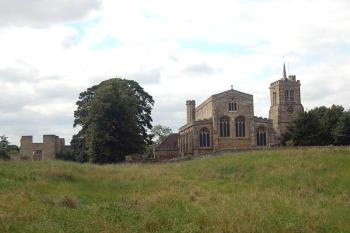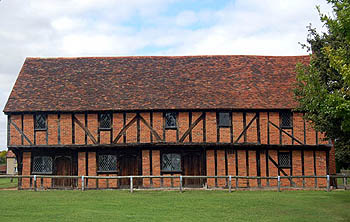Early Education in Elstow

Elstow Abbey from the east September 2007
Volume 81 published by the Bedfordshire Historical Records Society (2002) is devoted to returns made during episcopal visitations the county by the Bishop of Lincoln in the early 18th century, edited by former County Archivist Patricia Bell. The returns ask whether there was educational provision in the parish and the answers for Elstow are as follows:
- 1706: “There is no Lecture, School, Almes-house nor Hospitall in this parish”
- 1709: “No Public or Charity Schole, yet the cheife Inhabitants voluntarily pay for all poor children that are willing to learn. They are taught the Church Catechism”.
- 1712: “There is no school”.
Bedfordshire & Luton Archives & Records Service holds a report by James Lilburne to Samuel Whitbread II in 1802 about a number of Bedfordshire schools, including Elstow [W1/849], of which he says: "Buckle's Sunday School consists of between 25 & 30 Boys who are taught to Read; & is pretty well attended. The expence [sic] of it per Annum is about £5/12/-. Prigmore's Sunday School consist of between 25 & 30 Girls who are taught to Read; & is pretty well attended. The Expence of it per Annum is about £5/12/-. Both of the above Schools are Generally well attended, & there being no other school in the village, are of service".
In 1818 a Select Committee was established to enquire into educational provision for the poor. This was no doubt prompted, in part, by the recent foundation of two societies promoting education and specifically the building of schools. The Society for Promoting the Lancasterian System for the Education of the Poor was established in 1808 promoting schools run along the lines pioneered by Joseph Lancaster, who had himself copied those of Dr. Andrew Bell, in which older children taught their younger fellows. The Society was renamed the British and Foreign School Society in 1814. It was supported by a number of prominent nonconformists, Lancaster himself was a Quaker, and sought to teach a non-sectarian curriculum. In answer to this perceived nonconformist takeover of local education the National Society was firmed in 1811 to encourage the teaching of poor children along Anglican lines, including the catechism. The Select Committee sent a questionnaire to all parishes in the country asking for: particulars relating to endowments for the education of children; other educational institutions; observations of parish needs etc. The reply sent from Elstow stated that there was neither an endowment nor a school, the parson noting "Several of the children of the parish resort to day schools at Bedford, which is one mile distant".
In the country generally the number of schools built continued to grow over the next fifteen years so that by 1833 the government agreed to supplement the work of the two societies, and local benefactors, by making £20,000 per annum available in grants to help build schools. It also prompted another questionnaire to be sent to each parish in England asking for details of local educational provision. The return sent from Elstow in 1833 noted: "Four Daily Schools (chiefly for Lace-making), wherein 16 males and 27 females are instructed at the expense of their parents. Two Sunday Schools, one (commenced 1833) in which are 28 children of both sexes, supported by the minister; in the other are 30 of both sexes; it is supported by the Dissenters. The number of children in these Sunday Schools include those attending the Daily Schools". In those days a Sunday School was just that, a school which met on a Sunday, usually in the church or nonconformist chapel or other similar building, teaching more than the religious topics with which they are associated today. The dissenting Sunday School would have been run by the Bunyan Meeting, presumably in the Moot Hall. We know from an article by John Martin in The Northampton Mercury on 10th April 1847 that the Anglican Sunday School met in Vestry, often, wrongly, referred to as the Chapter House in the church.

Elstow Moot Hall September 2007
The next national enquiry was in 1846/7 when the Church of England made an enquiry as to all its church schools. This was against the background of a new Whig government which championed secular education and the increasing importance of nonconformists, particularly Wesleyan Methodist, and Roman Catholics in providing schools. Elstow reported that there was only the Sunday School, with an average attendance of 30 boys and 34 girls, and commenting, somewhat pompously: "A Daily school is a great desideratum".